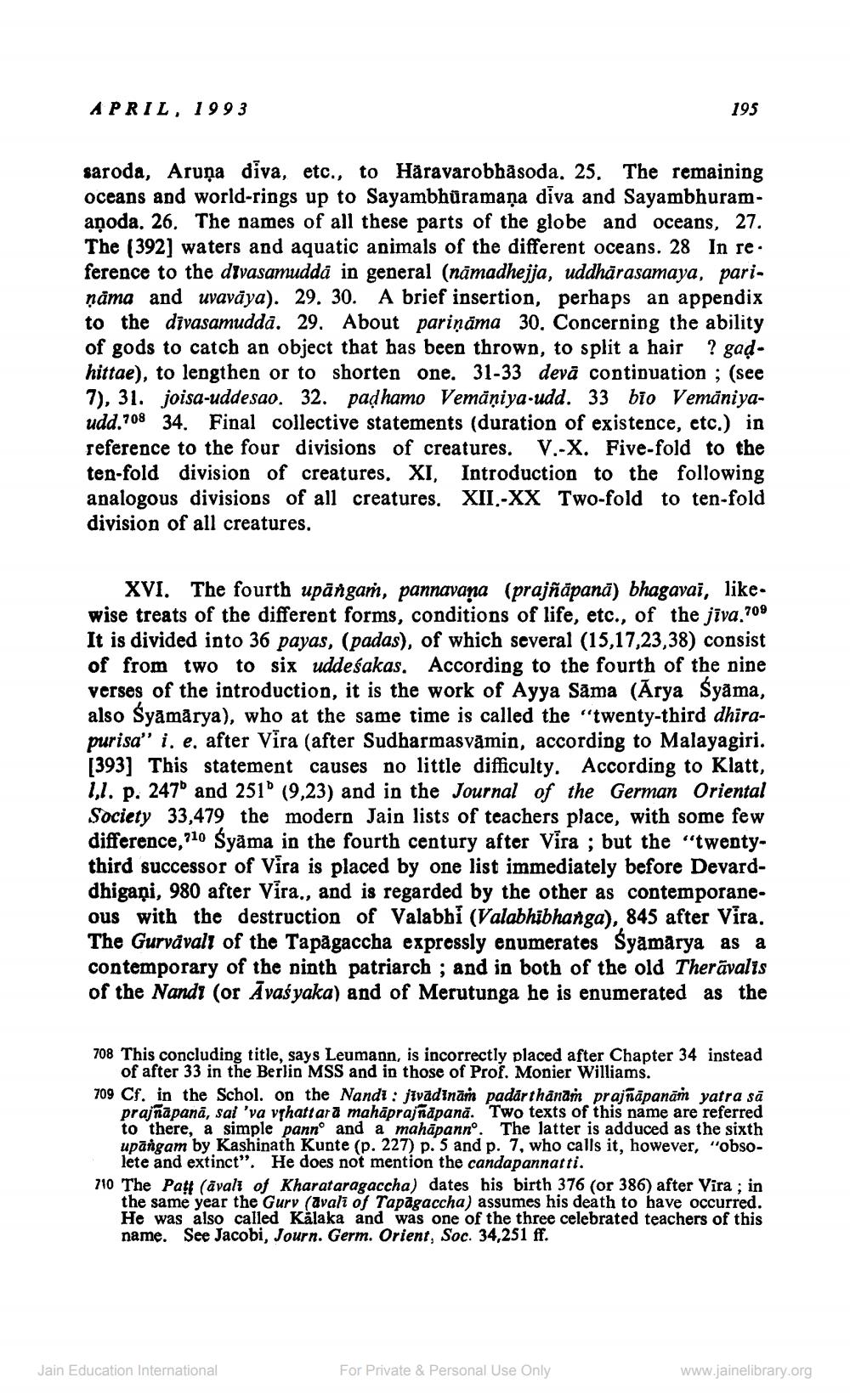________________
APRIL, 1993
saroda, Aruņa diva, etc., to Haravarobhāsoda. 25. The remaining oceans and world-rings up to Sayambhuramaņa dīva and Sayambhuramanoda. 26. The names of all these parts of the globe and oceans, 27. The [392] waters and aquatic animals of the different oceans. 28 In reference to the divasamudda in general (nāmadhejja, uddhārasamaya, pariṇāma and uvavāya). 29. 30. A brief insertion, perhaps an appendix to the divasamuddā. 29. About pariņāma 30. Concerning the ability of gods to catch an object that has been thrown, to split a hair ? gaḍhittae), to lengthen or to shorten one. 31-33 deva continuation; (see 7), 31. joisa-uddesao. 32. paḍhamo Vemāniya-udd. 33 bio Vemāniyaudd.708 34. Final collective statements (duration of existence, etc.) in reference to the four divisions of creatures. V.-X. Five-fold to the ten-fold division of creatures. XI, Introduction to the following analogous divisions of all creatures. XII-XX Two-fold to ten-fold division of all creatures.
195
XVI. The fourth upāngaṁ, pannavaṇa (prajñāpanā) bhagavai, likewise treats of the different forms, conditions of life, etc., of the jiva.709 It is divided into 36 payas, (padas), of which several (15,17,23,38) consist of from two to six uddeśakas. According to the fourth of the nine verses of the introduction, it is the work of Ayya Sāma (Arya Śyāma, also Śyamarya), who at the same time is called the "twenty-third dhirapurisa" i. e. after Vira (after Sudharmasvamin, according to Malayagiri. [393] This statement causes no little difficulty. According to Klatt, 1,1. p. 247 and 251° (9,23) and in the Journal of the German Oriental Society 33,479 the modern Jain lists of teachers place, with some few difference, 710 Syama in the fourth century after Vira; but the "twentythird successor of Vira is placed by one list immediately before Devarddhigani, 980 after Vira., and is regarded by the other as contemporaneous with the destruction of Valabhi (Valabhibhanga), 845 after Vira. The Gurvavall of the Tapagaccha expressly enumerates Syamarya as contemporary of the ninth patriarch; and in both of the old Theravalis of the Nandi (or Avasyaka) and of Merutunga he is enumerated as the
a
708 This concluding title, says Leumann, is incorrectly placed after Chapter 34 instead of after 33 in the Berlin MSS and in those of Prof. Monier Williams.
709 Cf. in the Schol. on the Nandi: jivadinam padarthānāṁ prajñāpanam yatra sā prajñāpanā, sal 'va vṛhattara mahāprajñāpană. Two texts of this name are referred to there, a simple pann and a mahapann. The latter is adduced as the sixth upangam by Kashinath Kunte (p. 227) p. 5 and p. 7, who calls it, however, "obsolete and extinct". He does not mention the candapannatti.
710 The Patt (avali of Kharataragaccha) dates his birth 376 (or 386) after Vira; in the same year the Gurv (avali of Tapagaccha) assumes his death to have occurred. He was also called Kalaka and was one of the three celebrated teachers of this name. See Jacobi, Journ. Germ. Orient, Soc. 34,251 ff.
Jain Education International
For Private & Personal Use Only
www.jainelibrary.org




